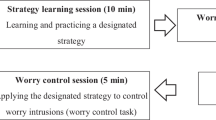Abstract
Fifty-seven participants were selected to represent a wide range on the dimension of worry proneness. They monitored and listed their worrisome thoughts in a diary for 7 days, and rated the uncontrollability of each recorded worry episode. Content analysis revealed that 48% of worrisome thoughts could be categorized as reflecting a problem-solving process, 17% as anticipation of future negative outcomes, 11% as “rumination,” and 5% as reflecting “palliative” thoughts and “self blame.” The extent of negative outcome anticipation or problem solving did not covary with worry severity. Higher trait worry proneness and more frequent and uncontrollable worrying during the monitoring period were associated with more rumination and fewer reports of successful solutions to problems. The results suggest that worry consists largely of attempted problem solving, and that one possible mechanism in the emergence of pathological worry may be a failure to bring problem solving to a satisfactory conclusion.
Similar content being viewed by others
REFERENCES
American Psychiatric Association. (1994). Diagnostic and Statistical Manual of Mental Disorders IV (DSMIV). Washington DC: Author.
Borkovec, T. D. (1994). The nature, functions, and origins of worry. In G. C. L. Davey & F. Tallis (Eds.), Worrying: Perspectives on theory, assessment and treatment (Chap. 1, pp. 5–35). Chichester: Wiley.
Borkovec, T. D., & Roemer, L. (1995). Perceived functions of worry among generalized anxiety disorder subjects: Distraction from more emotionally distressing topics? Behavior Therapy and Experimental Psychiatry, 26, 25–30.
Borkovec, T. D., Ray, W. J., & Stober, J. (1998). Worry: A cognitive phenomenon intimately linked to affective, physiological and interpersonal behavioural processes. Cognitive Therapy and Research, 22, 561–576.
Cartwright-Hatton, S., & Wells, A. (1997). Beliefs about worry and intrusions: The meta-cognitions questionnaire and its correlates. Journal of Anxiety Disorders, 11, 279–296.
Clark, D. A., & Purdon, C. L. (1995). The assessment of unwanted intrusive thoughts: A review and critique of literature. Behaviour Research and Therapy, 33, 967–976.
Craske, M. G., Rapee, R. M., Jackel, L., & Barlow, D. H. (1989). Qualitative dimensions of worry in DSM-III-R generalized anxiety disorder subjects and nonanxious controls. Behaviour Research and Therapy, 27, 397–402.
Davey, G.C. L. (1994). Pathological worrying as exacerbated problem solving. In G.C. L. Davey & F. Tallis (Eds.), Worrying: Perspectives on theory, assessment and treatment. (Chap. 2, pp. 35–61). Chichester: Wiley.
Davey, G.C. L., & Levy, S. (1999). Internal statements associated with worrying. Personality and Individual Differences, 26, 21–23.
Davey, G. C. L., Tallis, F., & Capuzzo, N. (1996). Beliefs about the consequences of worrying. Cognitive Therapy and Research, 20, 499–520.
D'Zurilla, T. J., & Nezu, A. M. (1990). Development and preliminary evaluation of the Social Problem Solving Inventory. Psychological Assessment: A Journal of Consulting and Clinical Psychology, 2, 156–163.
Freeston, M. H., Rheaume, J., Letarte, H., Dugas, M. J., & Ladouceur, R. (1994). Why do people worry? Personality and Individual Differences, 17, 791–802.
Ladouceur, R., Blais, F., Freeston, M. H., & Dugas, M. J. (1998). Problem solving and problem orientation in Generalized Anxiety Disorder. Journal of Anxiety Disorders, 12, 139–152.
Ladouceur, R., Talbot, F., & Dugas, M. (1997). Behavioural expressions of intolerance of uncertainty in worry. Behavior Modification, 21, 355–371.
Mathews, A. (1990).Why worry? The cognitive function of anxiety. Behaviour Research and Therapy, 28, 455–468.
Meyer, T. J., Miller, M. L., Metzger, R. L., & Borkovec, T. D. (1990). Development and validation of the Penn StateWorry Questionnaire. Behaviour Research and Therapy, 28, 487–495.
Molina, S., Borkovec, T. D., Peasly, C., & Person, D. (1998). Content analysis of worrisome streams of consciousness in anxious and dysphoric participants. Cognitive Therapy and Research, 22, 109–123.
Newman, M. G., Zuellig, A. R., Kachin, K. E., & Constantino, M. J. (1997, November). Examination of the reliability and validity of the GADQ-IV: A revised self-report measure of Generalised Anxiety Disorder. Poster presented at the 31st Conference of the Association for Advancement of Behavior Therapy, Miami, FL.
Nolen-Hoeksema, S., Morrow, J., & Fredrickson, B. J. (1993). Response styles and the duration of episodes of depressed mood. Journal of Abnormal Psychology, 102, 20–28.
Stanley, B., & Gibson, A. J. (1985). The prevalence of chronic psychiatric morbidity. British Journal of Psychiatry, 140, 372–376.
Tallis, F., Davey, G. C. L., & Capuzzo, N. (1994). The phenomenology of nonpathological worry:Apreliminary investigation. In G. C. L. Davey & F. Tallis (Eds.),Worrying: Perspectives on theory, assessment and treatment (Chap. 3, pp. 61–91). Chichester: Wiley.
Tallis, F., & Eysenck, M. W. (1994). Worry: Mechanisms and modulating influences. Behavioural and Cognitive Psychotherapy, 22, 37–56.
Tallis, F., Eysenck, M., & Mathews, A. (1991). Elevated evidence requirements and worry. Personality and Individual Differences, 12, 21–27.
Wells, A., & Morrison, A. P. (1994). Qualitative dimensions of normal worry and normal obsessions: A comparative study. Behaviour Research and Therapy, 32, 867–870.
Wells, A. (1999). A cognitive model of generalized anxiety disorder. Behaviour Modification, 23, 526–555.
Author information
Authors and Affiliations
Rights and permissions
About this article
Cite this article
Szabó, M., Lovibond, P.F. The Cognitive Content of Naturally Occurring Worry Episodes. Cognitive Therapy and Research 26, 167–177 (2002). https://doi.org/10.1023/A:1014565602111
Issue Date:
DOI: https://doi.org/10.1023/A:1014565602111




